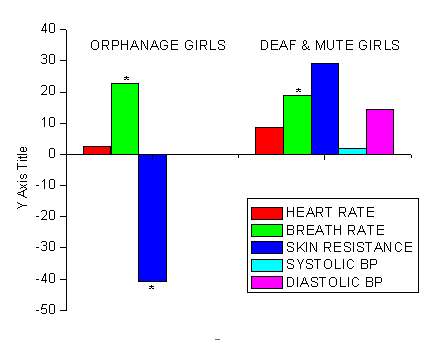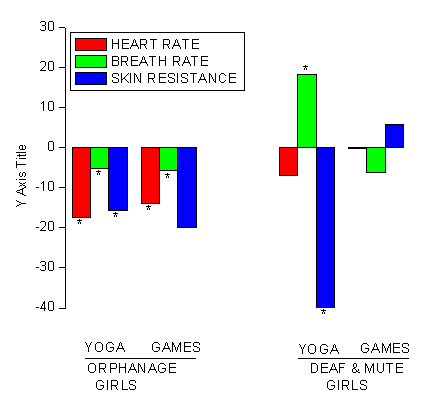YOGA AND GAMES AS PSYCHOTHERAPY FOR ORPHANAGED AND DEAF MUTE CHILDREN
Download PDF
This study was designed to evaluate (a) autonomic parameters in two categories of subjects (age range 14 ± 2 years), viz. orphanage girls (OG), and deaf and mute subjects (DM) with appropriate age-matched, control groups i.e. children staying at home and those normal subjects. (b) To compare the effect of yoga with games in the OG group and the effects of yoga with in the DM group.
YOGA AND GAMES AS PSYCHOTHERAPY FOR ORPHANAGED AND DEAF MUTE CHILDREN
Arvind V Patil*, Prathap Singh Tiwari** and Majeed*** (* Research Fellow and corresponding author, ** Director, *** Research Fellow) Department of Physical Education Gulbarga University, Gulbarga- 585 106 (Karnataka)
Abstract:
This study was designed to evaluate (a) autonomic parameters in two categories of subjects (age range 14 ± 2 years), viz. orphanage girls (OG), and deaf and mute subjects (DM) with appropriate age-matched, control groups i.e. children staying at home and those normal subjects. (b) To compare the effect of yoga with games in the OG group and the effects of yoga with gardening in the DM group.
Recordings were made of respiration, ECG, and skin resistance. The orphanage group were randomly assigned to yoga and games groups and followed up after six months, while for the deaf and mute group subjects were randomly assigned to yoga and physical activity group with a follow up after three weeks. In the first comparison orphanage girls had significantly faster, irregular breathing (indicative of anxiety) and lower skill resistance, while deaf and mute children had faster, irregular breathing and higher heart rates and diastolic blood pressure values. In the second comparison the yoga groups of both categories of subjects showed a decrease in breath rate, which became more rhythmic. Hence a yoga program including relaxation and awareness is useful in the handling of these subjects.
YOGA AND GAMES AS PSYCHOTHERAPY FOR ORPHANAGED AND DEAF MUTE CHILDREN
Arvind V Patil*, Prathap Singh Tiwari** and Majeed*** (* Research Fellow and corresponding author, ** Director, *** Research Fellow) Department of Physical Education Gulbarga University, Gulbarga- 585 106 (Karnataka)
INTRODUCTION : Mental arousal may be correlated with diverse factors related to family or environment, as well as the status of one's corporeal and mental health. For example children in a community home in Finland were described as physically normally developed but were socially and emotionally disturbed (Ahvenainen et al., 1984). A report on physiological measures showed that the resting electrical activity of selected facial and back muscles was significantly higher in community home boys than in a control group of the same age in an ordinary school (Rauhala et al., 1990). Another group of subjects who were reported to have significantly greater levels of anxiety than usual is subjects with impaired vision. This greater anxiety was specially related to physical threat (Ollendick et al., 1985). The practice of yoga is known to reduce autonomic arousal (Wallace et al., 1971; Joseph et al., 1981). Increased physical activity has shown to reduce autonomic reactivity to mental stressors.
The present study compares the autonomic arousal of two groups of subjects, i.e. orphanage girls and physically disadvantaged deaf and mute girls. Both groups were compared to their respective control groups. The second part of the study describes and compares the use of yoga with games or physical activity such as gardening.
METHOD :
Part I consisted of 28 orphanage girls with ages of 14 ± 2 years. They all had a history of difficulty in adjusting in society. A comparison was made with 28 age-matched girls who were attending a regular school and staying at home. Also twenty eight deaf and mute girls of the same age-range were compared with all equal number of aged girls who could hear and speak normally. In part II orphanage girls were divided into pairs matched for age and period of stay in the orphanages. Girls of a pair were randomly assigned to yoga and games. The follow up was carried out after 6 months. Also, 24 deaf and mute children were divided into pairs matched for age, sex. Girls of a pair were randomly assigned to yoga and games groups. The record was carried out after 21 days.
Measurements:
Measurements for part 1 were made under identical conditions. A moderately lit, sound attenuated small house was used for recording. After 15 minutes
of rest assessments were made for 10 minutes while subjects were seated at no intricacy.
A polygraph was used to record the Electrocardiogram (ECG), respiration, and the skin resistance. The ECG was recorded using standard limb lead 1
configuration. Skin resistance was recorded using silver chloride disc electrodes filled with electrode paste, and placed in contact with the volar
surfaces of the distal phalanges of the index and middle fingers of the left hand. A constant current of 10 microamperes was passed between the
electrodes. Respiration was recorded using a volumetric pressure transducer. Girls were asked to stand erect and transducer was fixed around the trunk,
approximately 5 cm below the lower costal margin. The blood pressure was also recorded.
Yoga techniques included Simple yogasanas, postures which are maintained
for as long as possible (50 minutes) and guided relaxation in shavasan
(10 minutes). The games session included jogging in place. Rapid bending forward and backwards, twisting, and bending sideways (40 minutes) as well as
games such as relay races in which all the girls had to take an active part for 20 minutes. The physical activity program consisted of working in the
garden, with comparable physical exercise as that of the yoga program, involving a similar amount of bending or stretching.
DATA ANALYSIS
: The heart rate in beats per minute was obtained by counting the number of QRS complexes in successive 60-sec epochs continuously. The skin resistance
(in kilo ohms) was sampled at 20-sec intervals continuously. The breath rate in breath cycles per minute was obtained by counting the breath cycles in
60-sec epochs continuously. For each subject the average of values obtained during the 10-min recording session were analyzed. In Part I of the study
comparisons were made using the Mann Whitney U test. In part II comparisons between yoga and the corresponding group were made using the Wilcoxon
signed ranks test.
RESULTS
Part I: The orphanage group had significantly faster breath rates and lower skin resistance values than the regular school group (Graph - I). The group
with deaf and mute subjects had significantly higher heart rates, breath rates and higher diastolic blood pressure values than the group with normal
vision.
Graph I : Percentage change in autonomic parameters in orphanage girls, and deaf and mute girls with reference to their respective control groups. +, - indicates increase, decrease respectively. * indicates significant difference compared to the respective controls.

Part II: Both the orphanage groups (yoga, games) showed significant reductions in heart rate through the magnitude of change was similar to non significant decrease in breath rate following 6 months of the programs (Graph-II). The yoga group alone showed a decrease in breath rate though the magnitude of change was similar to the non- significant decrease in breath rate seen in the games group. In the deaf and mute subjects the yoga group showed a significant decrease in breath rate.
Graph II: Percentage changes in autonomic parameter in both groups of orphanage girls and deaf and mute girls.

+, - indicates increase, decrease respectively * indicates significant difference when data from at the start and end of the programs compared
DISCUSSION: Part I of the study showed that orphanage girls had significantly higher heart rates and lower skin resistance values than girls of the same age who were living at home. Also the deaf and mute subjects had significantly higher heart rates, breath rates and diastolic blood pressure values compared to children with normal girls. Part II of the study showed that within both categories of subjects (orphanage girls, deaf and mute) the yoga groups showed significant reductions in breathe rates. In the orphanage girls group both yoga and games group showed decreases in heart rates. It was interesting to note that the changes in skin resistance occurred in opposite directions for the yoga and non-yoga groups of both categories of girls. The orphanage girl's yoga group showed an increase in skin resistance, while the games group showed a decrease in skin resistance. The reverse was true for the deaf and mute subjects.
Both the orphanage girls and deaf and mute subjects showed signs of physiological arousal. These results were similar to previous reports on community home boys (Rauhala et al., 1990) and the visually impaired (Wycherley & Nicklin. 1970). The most obvious difference between the groups was that the orphanage girls group had a lower skin resistance than normal and the deaf and mute had a higher skin resistance than normal. Both categories of subjects reduced their breath rates following yoga. Visual inspection of the records of both categories of subjects showed that both the orphanage girls and deaf and mute subjects showed more irregular breath patterns than the corresponding control subjects. Fear and anxiety were likely bases for irregular breathing i.e., very rapid and jerky (Ax. 1953; Bloch et al., 1991). The fear and anxiety of the orphanage girls group were believed to be related to social insecurity, whereas that of the deaf and mute subjects was attributed to fear of physical injury in the unfamiliar setting (Ollendick et al., 1985). Also there was a difference in skin resistance values the orphanage girls yoga group showed an increase, whereas the deaf and mute yoga group showed a decrease in skin resistance values. This was especially interesting as the orphanage girls group had a lower skin resistance to begin with, while that of the deaf and mute was higher than the control initially. Hence it appeared that the practice of yoga not only reduced arousal but also served to normalize other functions in both categories of subjects
REFERENCE:
1. Ahvenainen O, Lindholm H and Nikkanen P (1984): Community Home students in Spring, 1981, (National Board of Social Wellfore, Finland)
2. Ax AF (1953): The physiologic differentiation between fear and anger in humans, Psychological Medicine. 15, 433-442.
3. Bloch S, Lemeignan M, and Aguilera TN (1991): Specific respiratory patterns distinguish among human basic emotions, Intl. J. of Psychophysiology. 11, 141-154.
4. Joseph S, Sridharan SKB, Patil MD, Kumaria A, Selvamurthy W, Joseph NT, and Nayar HS (1981): Study of some physiological and biochemical parameters
in subjects undergoing yogic training, Ind. J. Med. Res. 74, 120-124.
5. Ollendick TH, Matson JL and Helsel WJ (1985): Fears in visually impaired and normally sighted youths, Behavioral Res. Therapy. 23(3),
375-378.
6. Rauhala E, Alho H, Hanninen O and Helin P (1990): Relaxation trailing combined with increased physical activity lowers psychophysiological
activation in community homeboys, Intl. J. of Psychophysiology. 10, 63-68.
7. Wallace RK, Benson H and Wilson AF (1971): A wakeful hypometabolic physiologic state. American J. of Physiol. 221, 785-799.
8. Wycherley RJ and Nicklin BH (1970): The heart rate of blind and sighted pedestrians on a town route. Ergonomics. 13(2), 181-192.

















